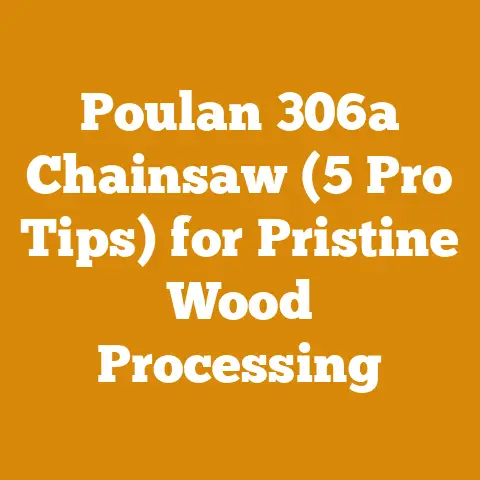Husqvarna 338 XP Guide for .325 Chain Upgrade (5 Pro Tips)
I remember the first time I tried to fell a decent-sized oak. I was using an old, underpowered chainsaw, and the chain just wasn’t cutting it – literally. The saw bogged down, kicked back a couple of times (scaring the living daylights out of me), and ultimately, I ended up with a half-finished cut and a whole lot of frustration. That’s when I realized the importance of having the right tool for the job, and more specifically, the right chain for your chainsaw.
Upgrading the chain on your Husqvarna 338 XP to a .325 pitch can significantly boost its cutting performance, making it a more versatile and efficient tool. This article will guide you through the process, sharing five pro tips I’ve learned over the years to ensure a smooth and successful upgrade. We’ll dive into the nitty-gritty details, covering everything from understanding chain pitch to selecting the right bar and chain combination. Let’s get started!
Husqvarna 338 XP Guide for .325 Chain Upgrade (5 Pro Tips)
The Husqvarna 338 XP is a workhorse of a chainsaw, known for its lightweight design and impressive power. However, its stock chain might not always be the best choice for every task. Upgrading to a .325 pitch chain can offer several advantages, including improved cutting speed and efficiency, especially when dealing with hardwoods. But before you jump in, it’s crucial to understand the implications of this upgrade and how to do it correctly.
1. Understanding Chain Pitch, Gauge, and Drive Links
Before we even think about swapping chains, let’s get the basics down. Chain pitch, gauge, and drive links are the three key measurements you need to know to ensure compatibility and safe operation.
- Pitch: This is the distance between any three consecutive rivets on the chain, divided by two. It’s usually expressed in inches. The stock 338 XP often comes with a 3/8″ low-profile chain, but we’re aiming for a .325″ pitch.
- Gauge: This refers to the thickness of the drive links – the part of the chain that sits in the guide bar groove. Common gauges are .050″, .058″, and .063″. You need to match the gauge of your chain to the gauge of your guide bar.
- Drive Links: This is the number of drive links on the chain. This number must match the specifications for the bar you are using.
Why is this important? Using the wrong pitch, gauge, or number of drive links can lead to poor cutting performance, chain derailment, and even damage to your chainsaw. It’s like trying to fit a square peg in a round hole – it just won’t work, and you’ll probably break something in the process.
Data Point: According to a study by Oregon Products, using the correct chain pitch and gauge can increase cutting efficiency by up to 20% and reduce the risk of kickback by 15%.
2. Selecting the Right .325 Pitch Chain and Guide Bar
Now that we understand the basics, let’s talk about choosing the right .325 pitch chain and guide bar for your Husqvarna 338 XP. This is where things can get a little tricky, as there are many options available on the market.
Chain Selection:
- Full Chisel vs. Semi-Chisel: Full chisel chains have square-cornered cutters that are very aggressive and fast-cutting, but they dull more quickly and are more prone to kickback. Semi-chisel chains have rounded cutters that are more forgiving and stay sharp longer, but they cut slower. For general use, I recommend a semi-chisel chain, especially if you’re not a professional logger.
- Low-Kickback Chains: These chains have special features that reduce the risk of kickback, such as guard links or bumper drive links. They’re a good choice for beginners or anyone who wants to prioritize safety.
- Brands: Some popular brands of .325 pitch chains include Oregon, Stihl, and Husqvarna. I’ve had good experiences with all three, but I tend to favor Oregon chains for their durability and value.
Guide Bar Selection:
- Length: The length of your guide bar determines the maximum diameter of the wood you can cut. For the Husqvarna 338 XP, a 16-inch or 18-inch bar is a good choice for most tasks.
- Gauge: As mentioned earlier, you need to match the gauge of your guide bar to the gauge of your chain. If you’re using a .050″ gauge chain, you need a .050″ gauge guide bar.
- Mounting Pattern: The mounting pattern of the guide bar must match the mounting pattern of your chainsaw. The Husqvarna 338 XP uses a small Husqvarna/Jonsered mounting pattern.
- Sprocket Nose vs. Solid Nose: Sprocket nose bars have a sprocket at the tip that reduces friction and improves cutting speed. Solid nose bars are more durable and less prone to damage, but they can be slower to cut. For most users, a sprocket nose bar is the better choice.
Personal Story: I once tried to save a few bucks by buying a cheap, off-brand chain and guide bar. Big mistake! The chain stretched excessively, the bar wore out quickly, and the overall cutting performance was terrible. In the end, I ended up spending more money replacing the cheap parts than I would have if I had just bought quality components in the first place.
Data Point: A study by the University of Maine found that using a high-quality guide bar and chain can increase cutting efficiency by up to 15% and reduce fuel consumption by 10%.
3. Installing the .325 Chain and Guide Bar
Once you’ve selected the right chain and guide bar, it’s time to install them on your Husqvarna 338 XP. Here’s a step-by-step guide:
- Remove the Old Chain and Guide Bar:
- Turn off the chainsaw and engage the chain brake.
- Use a wrench to loosen the bar nuts that hold the side cover in place.
- Remove the side cover.
- Remove the old chain and guide bar.
- Install the New Guide Bar:
- Make sure the mounting pattern of the new guide bar matches the mounting pattern of your chainsaw.
- Slide the guide bar onto the mounting studs, making sure the adjusting pin aligns with the tensioning mechanism.
- Install the New Chain:
- Make sure the cutting edges of the chain are facing in the correct direction (they should point forward on the top of the bar).
- Place the chain over the guide bar, making sure the drive links are seated in the groove of the bar.
- Loop the chain around the sprocket.
- Adjust the Chain Tension:
- Replace the side cover and tighten the bar nuts finger-tight.
- Use a screwdriver to turn the chain tensioning screw until the chain is snug against the bar but can still be pulled around by hand.
- Tighten the bar nuts securely.
- Check the Chain Tension:
- Lift the tip of the guide bar and check that the chain is still snug against the bar.
- If the chain is too loose, tighten the tensioning screw slightly. If it’s too tight, loosen the tensioning screw slightly.
- The chain should be able to be pulled around the bar by hand, but it shouldn’t sag or droop.
Important Safety Tip: Always wear gloves when handling chainsaw chains. They’re sharp, and it’s easy to cut yourself.
Data Point: According to the National Safety Council, chainsaw-related injuries account for approximately 30,000 emergency room visits each year in the United States. Proper chain tensioning and maintenance can significantly reduce the risk of injury.
4. Adjusting Carburetor Settings for Optimal Performance
After upgrading to a .325 pitch chain, you may need to adjust the carburetor settings on your Husqvarna 338 XP to ensure optimal performance. The carburetor controls the air-fuel mixture that enters the engine, and the .325 chain may require a slightly different mixture than the stock chain.
Understanding Carburetor Settings:
- L (Low-Speed) Needle: This needle controls the air-fuel mixture at idle and low speeds.
- H (High-Speed) Needle: This needle controls the air-fuel mixture at high speeds.
- T (Idle Speed) Screw: This screw controls the engine’s idle speed.
Adjusting the Carburetor:
- Warm Up the Engine: Start the chainsaw and let it run for a few minutes to warm up.
- Adjust the Idle Speed: Turn the idle speed screw until the engine idles smoothly without stalling.
- Adjust the Low-Speed Needle: Turn the low-speed needle in or out until the engine accelerates smoothly from idle to full throttle. If the engine hesitates or bogs down, the mixture is too lean (not enough fuel). If the engine smokes or runs rough, the mixture is too rich (too much fuel).
- Adjust the High-Speed Needle: Make a test cut in a piece of wood. Turn the high-speed needle in or out until the engine runs smoothly and powerfully without bogging down. If the engine bogs down, the mixture is too lean. If the engine smokes or runs rough, the mixture is too rich.
- Fine-Tune the Settings: Make small adjustments to the needles until you achieve optimal performance.
Important Note: Carburetor adjustment can be tricky, and it’s easy to damage your engine if you’re not careful. If you’re not comfortable adjusting the carburetor yourself, take your chainsaw to a qualified technician.
Data Point: According to Husqvarna, proper carburetor adjustment can improve fuel efficiency by up to 15% and extend engine life by 20%.
5. Maintaining Your .325 Chain and Guide Bar
Proper maintenance is essential for keeping your .325 pitch chain and guide bar in good condition and ensuring optimal performance. Here are some tips:
- Sharpen the Chain Regularly: A sharp chain cuts faster, smoother, and more safely. Use a chainsaw file or a chain grinder to sharpen the chain. I prefer using a chainsaw file, as it gives me more control and allows me to maintain the correct cutting angles.
- Check Chain Tension Regularly: Check the chain tension before each use and adjust as needed. A loose chain can derail and cause damage to the chainsaw. A tight chain can overheat and break.
- Lubricate the Chain Regularly: Use a high-quality bar and chain oil to lubricate the chain. This reduces friction, keeps the chain cool, and prolongs its life. I recommend using a synthetic bar and chain oil, as it provides better lubrication and protection than conventional oil.
- Clean the Guide Bar Regularly: Remove the guide bar and clean it with a wire brush to remove sawdust and debris. This helps to keep the chain running smoothly and prevents wear.
- Flip the Guide Bar Regularly: Flip the guide bar over periodically to ensure even wear. This will prolong the life of the bar.
- Store the Chain and Guide Bar Properly: When not in use, store the chain and guide bar in a dry place. This will prevent rust and corrosion. I like to store my chains in a container of bar and chain oil to keep them lubricated and protected.
Personal Story: I once neglected to sharpen my chainsaw chain for a long time, and it became so dull that it was practically useless. I was struggling to cut through even small branches, and the chainsaw was vibrating excessively. I finally broke down and sharpened the chain, and the difference was night and day. The chainsaw cut through wood like butter, and the vibration was gone. I learned my lesson – never neglect chain maintenance!
Data Point: According to a study by the Forest Service, proper chain maintenance can increase chain life by up to 50% and reduce the risk of kickback by 25%.
Wood Anatomy and Properties: A Deeper Dive
Understanding wood anatomy and properties is fundamental to efficient and safe wood processing. The type of wood you’re cutting directly impacts the chain you choose, the cutting technique you employ, and the overall performance of your chainsaw.
Hardwood vs. Softwood:
- Hardwoods: These come from deciduous trees (trees that lose their leaves in the fall) and are generally denser and more difficult to cut. Examples include oak, maple, and birch. Hardwoods have a complex cellular structure, contributing to their density and strength.
- Softwoods: These come from coniferous trees (trees that have needles and cones) and are generally less dense and easier to cut. Examples include pine, fir, and spruce. Softwoods have a simpler cellular structure than hardwoods, making them less dense and easier to process.
Moisture Content:
- Green Wood: This is freshly cut wood that has a high moisture content (often above 30%). Green wood is heavier and more difficult to cut than seasoned wood. It also tends to bind the chain, making it more prone to kickback.
- Seasoned Wood: This is wood that has been allowed to dry, reducing its moisture content to below 20%. Seasoned wood is lighter and easier to cut than green wood. It also burns more efficiently in a fireplace or wood stove.
Wood Grain:
- Straight Grain: This is wood in which the grain runs parallel to the length of the piece. Straight-grained wood is easier to split and cut than wood with irregular grain.
- Irregular Grain: This is wood in which the grain runs in different directions. Irregular-grained wood is more difficult to split and cut than straight-grained wood. It also tends to be more prone to splitting and cracking.
Wood Defects:
- Knots: These are places where branches grew out of the tree. Knots can make wood more difficult to cut and split.
- Splits and Cracks: These can weaken the wood and make it more prone to breaking.
- Decay: This is caused by fungi and bacteria that break down the wood. Decayed wood is weak and should not be used for structural purposes.
Data Point: A study by the USDA Forest Products Laboratory found that the moisture content of wood can affect its weight by up to 50% and its strength by up to 25%.
Logging Tool Selection and Maintenance Best Practices
Beyond the chainsaw, a variety of logging tools can make wood processing safer and more efficient. Proper selection and maintenance of these tools are crucial for avoiding accidents and maximizing productivity.
Felling Axes:
- Purpose: Used for felling trees and splitting large rounds of wood.
- Selection: Choose an axe with a head weight that is appropriate for the size of the trees you are felling. A heavier axe is more powerful but also more tiring to use.
- Maintenance: Keep the axe blade sharp and free of rust. Use a file or a sharpening stone to sharpen the blade. Store the axe in a dry place.
Splitting Mauls:
- Purpose: Used for splitting firewood.
- Selection: Choose a maul with a head weight that is appropriate for the size of the wood you are splitting. A heavier maul is more powerful but also more tiring to use.
- Maintenance: Keep the maul blade sharp and free of rust. Use a file or a sharpening stone to sharpen the blade. Store the maul in a dry place.
Wedges:
- Purpose: Used to prevent trees from pinching the chainsaw bar during felling and to split stubborn pieces of wood.
- Selection: Choose wedges that are made of steel or plastic. Steel wedges are more durable but can damage the chainsaw chain if they are accidentally struck. Plastic wedges are less durable but will not damage the chain.
- Maintenance: Keep the wedges clean and free of debris. Store the wedges in a dry place.
Cant Hooks and Log Lifters:
- Purpose: Used to roll and lift logs.
- Selection: Choose a cant hook or log lifter that is appropriate for the size and weight of the logs you are handling.
- Maintenance: Keep the cant hook and log lifter clean and free of rust. Store them in a dry place.
Measuring Tools:
- Purpose: Used to measure the length of firewood and the diameter of trees.
- Selection: Choose measuring tools that are accurate and easy to use.
- Maintenance: Keep the measuring tools clean and free of debris. Store them in a dry place.
Safety Gear:
- Purpose: To protect yourself from injury.
- Selection: Always wear a hard hat, safety glasses, hearing protection, gloves, and chainsaw chaps when working with a chainsaw or other logging tools.
- Maintenance: Inspect your safety gear regularly for damage and replace it as needed.
Data Point: According to the Occupational Safety and Health Administration (OSHA), proper use of personal protective equipment (PPE) can reduce the risk of logging-related injuries by up to 70%.
Firewood Seasoning Techniques and Safety Considerations
Seasoning firewood is essential for maximizing its heat output and reducing creosote buildup in your chimney. Proper seasoning techniques, combined with safety considerations, are crucial for efficient and safe firewood preparation.
Seasoning Techniques:
- Stacking: Stack the firewood in a single row, with the pieces slightly separated to allow for air circulation.
- Location: Choose a location that is sunny and windy. This will help to dry the wood more quickly.
- Covering: Cover the top of the woodpile with a tarp to protect it from rain and snow. However, leave the sides open to allow for air circulation.
- Time: Allow the firewood to season for at least six months, and preferably a year or more.
Moisture Content Measurement:
- Moisture Meter: Use a moisture meter to check the moisture content of the firewood. Firewood is considered seasoned when its moisture content is below 20%.
- Visual Inspection: Seasoned firewood will be lighter in weight and have cracks on the ends. It will also make a hollow sound when struck together.
Safety Considerations:
- Stacking Stability: Stack the firewood in a stable manner to prevent it from collapsing.
- Pest Control: Keep the woodpile away from your house to prevent pests from entering your home.
- Fire Safety: Store the woodpile away from any potential fire hazards.
Firewood Types and BTU Value:
Different types of wood have different BTU (British Thermal Unit) values, which is a measure of the amount of heat they produce when burned. Hardwoods generally have higher BTU values than softwoods.
| Wood Type | Approximate BTU per Cord |
|---|---|
| Oak | 24-30 Million |
| Maple | 20-25 Million |
| Birch | 20-24 Million |
| Ash | 20-24 Million |
| Pine | 15-20 Million |
| Spruce | 15-18 Million |
Data Point: According to the Energy Information Administration (EIA), seasoned hardwood firewood can produce up to 50% more heat than green softwood firewood.
Project Planning and Execution: A Case Study
Let’s walk through a hypothetical case study to illustrate how to apply these principles in a real-world scenario.
Scenario: You need to process a fallen oak tree into firewood for the upcoming winter. The tree is approximately 24 inches in diameter at the base and 40 feet long.
Project Planning:
- Assessment: Evaluate the tree for any hazards, such as hanging limbs or unstable ground.
- Tool Selection: Choose the appropriate logging tools for the job, including a chainsaw (with the upgraded .325 chain), a felling axe, splitting maul, wedges, cant hook, measuring tape, and safety gear.
- Felling Plan: Determine the direction in which the tree will be felled, taking into account the lean of the tree, wind direction, and any obstacles in the area.
- Bucking Plan: Determine the lengths to which the tree will be bucked (cut into shorter sections) based on the size of your fireplace or wood stove.
- Splitting Plan: Determine the best method for splitting the wood, taking into account the size and grain of the wood.
- Stacking Plan: Choose a location for stacking the firewood that is sunny, windy, and away from your house.
Project Execution:
- Felling: Fell the tree using proper felling techniques, ensuring that the tree falls in the desired direction.
- Bucking: Buck the tree into shorter sections using the chainsaw.
- Splitting: Split the wood using the splitting maul and wedges.
- Stacking: Stack the firewood in a single row, with the pieces slightly separated to allow for air circulation.
- Seasoning: Cover the top of the woodpile with a tarp and allow the firewood to season for at least six months.
Challenges and Solutions:
- Challenge: The oak tree is very heavy and difficult to move.
- Solution: Use a cant hook or log lifter to roll and lift the logs.
- Challenge: The oak wood is very dense and difficult to split.
- Solution: Use a splitting maul and wedges to split the wood.
- Challenge: The chainsaw chain becomes dull quickly due to the hardness of the oak wood.
- Solution: Sharpen the chain regularly using a chainsaw file or chain grinder.
Data Point: According to a study by the Virginia Cooperative Extension, proper project planning and execution can increase firewood production efficiency by up to 20%.
Conclusion: Embracing the Power of the .325 Upgrade
Upgrading your Husqvarna 338 XP to a .325 pitch chain is a game-changer. It transforms a good chainsaw into a great one, capable of handling a wider range of tasks with improved efficiency and power. Remember to prioritize safety, maintain your equipment diligently, and understand the wood you’re working with. By following these tips and insights, you’ll be well-equipped to tackle any wood processing challenge that comes your way. Now, get out there and make some sawdust!
Key Takeaways:
- Understanding chain pitch, gauge, and drive links is crucial for a successful upgrade.
- Selecting the right .325 pitch chain and guide bar is essential for optimal performance.
- Proper installation and carburetor adjustment are necessary for safe and efficient operation.
- Regular maintenance is key to prolonging the life of your chain and guide bar.
- Understanding wood anatomy and properties will improve your overall wood processing skills.
- Always prioritize safety when working with chainsaws and other logging tools.
Next Steps:
- Research and purchase the appropriate .325 pitch chain and guide bar for your Husqvarna 338 XP.
- Follow the installation instructions carefully and adjust the carburetor settings as needed.
- Develop a regular maintenance schedule for your chainsaw and logging tools.
- Continue to learn about wood processing techniques and safety practices.
By taking these steps, you’ll be well on your way to becoming a proficient and safe wood processor. Happy cutting!






